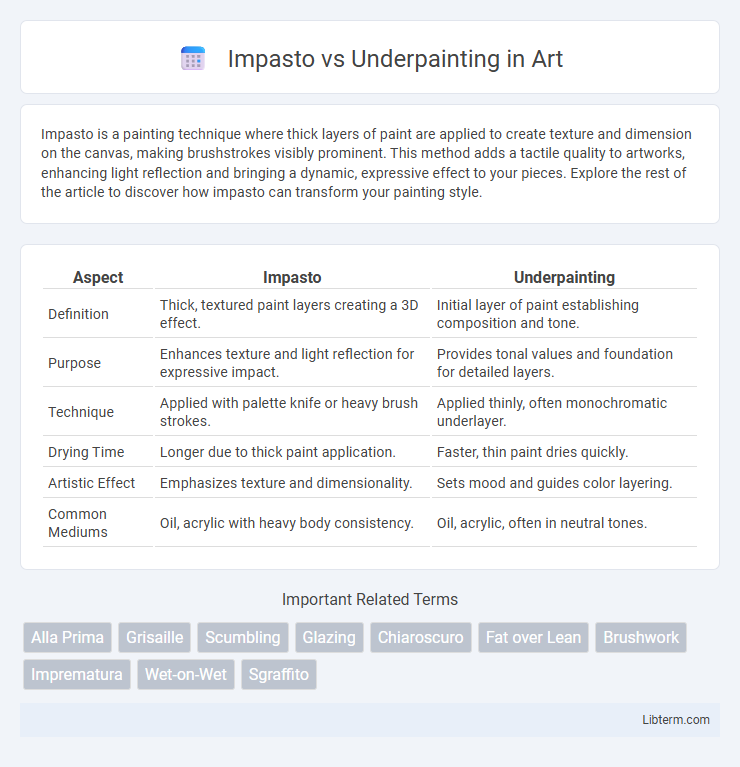Impasto is a painting technique where thick layers of paint are applied to create texture and dimension on the canvas, making brushstrokes visibly prominent. This method adds a tactile quality to artworks, enhancing light reflection and bringing a dynamic, expressive effect to your pieces. Explore the rest of the article to discover how impasto can transform your painting style.
Table of Comparison
| Aspect | Impasto | Underpainting |
|---|---|---|
| Definition | Thick, textured paint layers creating a 3D effect. | Initial layer of paint establishing composition and tone. |
| Purpose | Enhances texture and light reflection for expressive impact. | Provides tonal values and foundation for detailed layers. |
| Technique | Applied with palette knife or heavy brush strokes. | Applied thinly, often monochromatic underlayer. |
| Drying Time | Longer due to thick paint application. | Faster, thin paint dries quickly. |
| Artistic Effect | Emphasizes texture and dimensionality. | Sets mood and guides color layering. |
| Common Mediums | Oil, acrylic with heavy body consistency. | Oil, acrylic, often in neutral tones. |
Understanding Impasto: Definition and Techniques
Impasto is a painting technique that involves applying thick layers of paint, often oil or acrylic, to create textured, three-dimensional surfaces on the canvas. Artists use palette knives or stiff brushes to build up the paint, allowing light to reflect off the ridges and adding dynamic visual interest. This method contrasts with underpainting, where a thin, monochromatic base layer is applied to establish composition and tonal values before the final work.
What is Underpainting? A Foundational Art Method
Underpainting is a foundational art method involving the application of a monochromatic layer that serves as a tonal base for subsequent paint layers. This technique enhances depth and contrast by establishing values and composition before adding color, often using earth tones or grayscale. Unlike impasto, which emphasizes texture and thick paint application, underpainting focuses on creating a unified structure that guides the final artwork's color and detail development.
Key Differences Between Impasto and Underpainting
Impasto involves applying thick layers of paint to create texture and dimension, whereas underpainting serves as a monochromatic base layer to establish composition and values. Impasto emphasizes tactile effects and light reflection on the paint surface, while underpainting functions as an initial tonal guide to influence subsequent color layers. The key difference lies in impasto's focus on surface texture and visual impact, contrasted with underpainting's role in structuring and preparing the artwork.
Materials and Tools for Impasto and Underpainting
Impasto technique requires thick, viscous paints such as oil or heavy-body acrylics applied with palette knives, stiff brushes, or spatulas to create textured, three-dimensional surfaces. Underpainting relies on thinned paints or washes, often using oil, acrylic, or watercolor, applied with soft brushes to establish tonal values and composition beneath the final layers. Both methods utilize supports like canvas or panel, but impasto demands durable materials that withstand heavy paint application without warping.
Historical Development: Impasto vs Underpainting
Impasto originated in the Renaissance period, gaining prominence through artists like Rembrandt who used thick layers of paint to create texture and depth, while underpainting dates back to the early Italian Renaissance as a foundational monochromatic layer to establish the composition and tonal values. The development of impasto techniques evolved with the Impressionists, emphasizing light and brushstroke texture, contrasting with underpainting's role in the classical tradition of building complex compositions gradually. The historical evolution of both methods reflects differing artistic priorities: impasto prioritizing tactile expression and surface dynamics, underpainting focusing on structural groundwork and tonal harmony.
Visual Effects: Texture vs Tone
Impasto technique creates a tactile, three-dimensional texture by applying thick layers of paint, enhancing light reflection and adding dynamic visual interest to the artwork. Underpainting establishes tonal values and shading beneath the final layers, providing depth and tonal continuity without influencing surface texture. Comparing the two, impasto emphasizes surface texture and physicality, while underpainting focuses on tonal groundwork that guides the overall composition.
Popular Artists Who Used Impasto and Underpainting
Impasto technique, favored by artists like Vincent van Gogh and Willem de Kooning, involves applying thick layers of paint to create texture and expressive brushstrokes, enhancing the visual impact of the artwork. Underpainting, extensively used by masters such as Leonardo da Vinci and Rembrandt, serves as a monochromatic base layer that establishes tonal values and composition before applying final paint layers. Both techniques have shaped the evolution of painting styles by offering distinct approaches to texture and depth in masterpieces.
When to Use Impasto or Underpainting in Your Artwork
Impasto is ideal for adding texture and dimensionality when emphasizing bold, expressive brushstrokes to create tactile visual interest. Underpainting serves best as a foundational layer to establish tonal values, composition, and color harmony before applying subsequent paint layers. Artists choose impasto to enhance surface texture in finished works, while underpainting is used during early stages for structural depth and balanced color planning.
Common Mistakes and How to Avoid Them
Impasto techniques often suffer from overapplication, leading to cracked or heavy textures, while underpainting mistakes include insufficient drying time that causes color mixing or muddy results. Avoid these errors by applying thick paint layers gradually and allowing each layer to dry fully before proceeding with transparent or glaze layers in underpainting. Proper surface preparation and selecting compatible paints also ensure optimal adhesion and prevent peeling or flaking.
Combining Impasto and Underpainting for Dynamic Results
Combining impasto and underpainting techniques enhances artwork by layering thick, textured paint over a detailed, monochromatic base that establishes tonal values and composition. The underpainting provides depth and structure, while impasto adds dimensionality and vibrant surface interest, creating a dynamic interplay of light and shadow. This approach enriches visual complexity and tactile quality, engaging viewers with both color intensity and expressive texture.
Impasto Infographic

 libterm.com
libterm.com